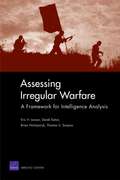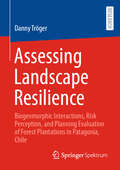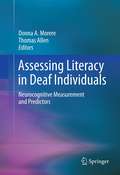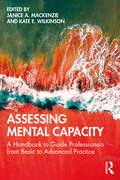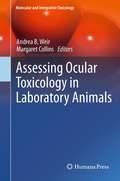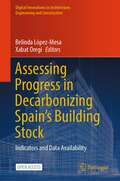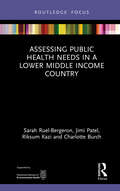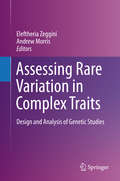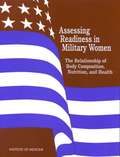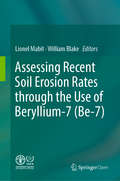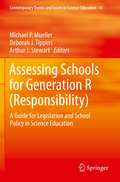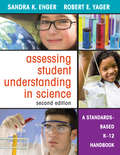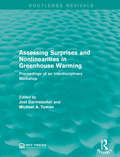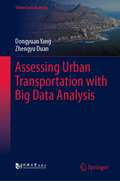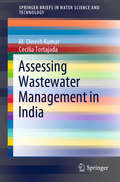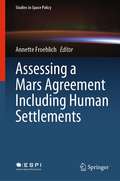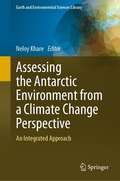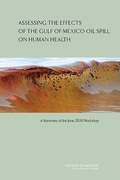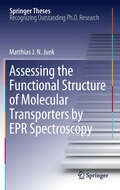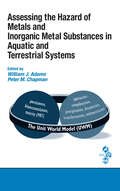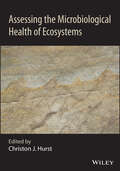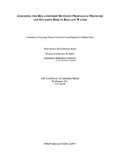- Table View
- List View
Assessing Irregular Warfare
by Eric V. Larson Brian Nichiporuk Derek Eaton Thomas S. SzaynaProvides an analytic framework and procedure for the intelligence analysis of irregular warfare (IW) environments that can serve as the basis for IW intelligence curriculum development efforts. Defines IW in terms of two stylized situations: population-centric (such as counterinsurgency) and counterterrorism. Provides a detailed review of IW-relevant defense policy and strategy documents and a list of relevant doctrinal publications.
Assessing Landscape Resilience: Biogeomorphic Interactions, Risk Perception, and Planning Evaluation of Forest Plantations in Patagonia, Chile
by Danny TrögerThis book examines the extent to which exotic pine plantations are a suitable strategy for maintaining the essential functions, structures, processes and identity of the Patagonian landscape over time. To this end, it integrates three empirical studies with inter- and transdisciplinary approaches under the theoretical framework of landscape resilience. The first study analyses the biogeomorphic interactions of different land uses and their relevance for soil conservation and landslide mitigation. The second study examines perceptions of natural hazards and focuses on networks of human and non-human actors that maintain landscape resilience. The results of these two studies are incorporated into the planning evaluation of land zoning and alternative strategies are developed, inspired by normative polycentric governance. It is concluded that Pinus plantations partially fulfil their ecological objectives of erosion control and landslide mitigation. However, their performance lags behind that of secondary forests with native species and they create new risks such as reduced biodiversity, increased risk of wildfires and conflicts with local identity. The book concludes with new research questions of trans-regional importance.
Assessing Literacy in Deaf Individuals: Neurocognitive Measurement and Predictors
by Donna Morere Thomas Allen<P>Humans' development of literacy has been a recent focus of intense research from the reading, cognitive, and neuroscience fields. But for individuals who are deaf--who rely greatly on their visual skills for language and learning--the findings don't necessarily apply, leaving theoretical and practical gaps in approaches to their education. <P>Assessing Literacy in Deaf Individuals: Neurocognitive Measurement and Predictors narrows these gaps by introducing the VL2 Toolkit, a comprehensive test battery for assessing the academic skills and cognitive functioning of deaf persons who use sign language. Skills measured include executive functioning, memory, reading, visuospatial ability, writing fluency, math, and expressive and receptive language. Comprehensive data are provided for each, with discussion of validity and reliability issues as well as ethical and legal questions involved in the study. And background chapters explain how the Toolkit was compiled, describing the procedures of the study, its rationale, and salient characteristics of its participants. This notable book: <br>Describes each Toolkit instrument and the psychometric properties it measures. <br>Presents detailed findings on test measures and relationships between skills. <br>Discusses issues and challenges relating to visual representations of English, including fingerspelling and lipreading. <br>Features a factor analysis of the Toolkit measures to identify underlying cognitive structures in deaf learners. <br>Reviews trends in American Sign Language assessment. <br>Assessing Literacy in Deaf Individuals is an essential reference for researchers, graduate students, clinicians, and other professionals working in the field of deafness and deaf education across in such areas as clinical child and school psychology, audiology, and linguistics.
Assessing Mental Capacity: A Handbook to Guide Professionals from Basic to Advanced Practice
by Janice A. Mackenzie Kate E. WilkinsonThis practical, how-to handbook provides essential resources to help clinicians and other professionals assess mental capacity in key decisions. The book illustrates the basics of capacity assessments before discussing a variety of complex issues of which professionals will need to be aware. Offering expertise from a multi-disciplinary perspective, the book provides hands-on coverage of mental capacity law (concentrating on England and Wales). This book is accompanied by online resources including semi-structured interviews and a multi-disciplinary team (MDT) questionnaire which can be downloaded and used for clinical cases, as well as further examples, information and tips. Please visit www.assessingcapacity.com. Chapters are written by a variety of different professionals with extensive experience in the assessment of mental capacity. Coverage includes: Explanations of mental capacity law and how to put it into practice across a range of settings, services and populations A "how to" approach for administering assessments of mental capacity both for professionals who are new to the area and for more experienced professionals Information on practical aspects of assessing mental capacity for commonly occurring decisions and for more specialist and complex decisions Consideration of the best interests process and Liberty Protection Safeguards (LPS). With easily accessible information, case studies, examples from case law and internationally relevant discussions on ethical issues, this is the perfect companion to help busy professionals understand complex concepts relating to mental capacity.
Assessing Ocular Toxicology in Laboratory Animals (Molecular and Integrative Toxicology)
by Margaret Collins Andrea B WeirOcular toxicity is routinely assessed in toxicology studies conducted for regulatory purposes. Ocular anatomy and physiology and the assessment of ocular toxicity itself can be challenging to scientists involved in the safety assessment of pharmaceuticals, pesticides and other agents. Anatomical and physiological differences between species can impact the nature of ocular effects observed following intended or unintended exposure of ocular tissues to xenobiotics. Ocular Toxicity in Laboratory Animals provides a concise reference addressing ocular anatomy and physiology across species that will enhance the design and interpretation of toxicology studies conducted for regulatory purposes. The book provides an overview of routine and advanced techniques that are used to assess ocular toxicity including slit lamp biomicroscopy, indirect ophthalmoscopy, electrophysiology and imaging methods for the anterior and posterior segments of the eye. Additionally, the book defines the regulatory expectations for pharmaceuticals intended to treat ocular diseases and for other non-pharmaceutical regulated chemicals. With contributions from experts in the field, Ocular Toxicity in Laboratory Animals is an authoritative, accessible guide for toxicologists and other scientists involved in conducting toxicology studies for regulatory purposes and/or reviewing data from such studies.
Assessing Pain and Communication in Disorders of Consciousness (Neuropsychological Rehabilitation: A Modular Handbook)
by Steven Laureys Camille ChatelleRecent advances in medicine for resuscitation and care have led to an increased number of patients that survive severe brain damage but who are poorly responsive and non-communicative at the bedside. This has led to a striking need to better characterize, understand, and manage this population who present a real challenge for the assessment of pain and for planning treatment. This edited collection provides clinicians with a guide to recent developments in research on pain perception and assessment, and the detection of consciousness and communication in patients with disorders of consciousness (DOC). With contributions from leading global researchers, the book gives an overview of issues concerning the assessment of pain. It also covers the development of suitable tools both to improve pain management and to detect consciousness and communication in these patients, to influence their prognosis and treatment, and their quality of life. Methodological and ethical issues concerning the implication for future research are also considered. The book will be an invaluable guide for clinicians, medics and therapists working in rehabilitation and acute care, particularly in the demanding field of pain perception, pain assessment and detection of consciousness and communication in patients with DOC. It will also be useful for students and researchers in neuropsychology and medical sciences.
Assessing Progress in Decarbonizing Spain’s Building Stock: Indicators and Data Availability (Digital Innovations in Architecture, Engineering and Construction)
by Belinda López-Mesa Xabat OregiThis open access book delves into the topic of monitoring the effectiveness of building renovation policies within the European Union (EU) using indicators. Given the substantial environmental impact of existing buildings on energy consumption and greenhouse gas emissions, decarbonizing them is imperative for achieving climate neutrality in Europe. The use of indicators for monitoring decarbonization progress and evaluating policies emerges as a valuable tool, ensuring the efficiency, effectiveness, and alignment of building renovation policies with broader sustainability and climate objectives. Additionally, this approach facilitates evidence-based decision-making, promotes accountability by Member States (MSs), supports the realization of long-term goals, and actively involves the public in these vital initiatives. The European Commission is actively engaged in this realm, releasing a framework of optional indicators in 2019 and subsequently refining it during the review of the Energy Performance of Buildings Directive. The evolving framework seeks to encompass both mandatory and optional indicators, posing greater challenges for EU MSs in monitoring the impact of their national building renovation policies and the progress of decarbonizing their building stocks. This book offers insights into these developing indicator frameworks, assesses the availability and quality of data in the case of Spain, and suggests areas of improvement and innovative approaches using emerging technologies to enhance data. The target audience includes diverse stakeholders such as central government administrations, regional and municipal authorities, data-collecting institutions, urban planners, researchers, and citizens interested in comprehending the impact of building renovation. By addressing this broad audience, the book aims to foster a more inclusive and well-informed discussion on building renovation and the decarbonization of the European building stock.
Assessing Public Health Needs in a Lower Middle Income Country (Routledge Focus on Environmental Health)
by Sarah Ruel-Bergeron Jimi Patel Riksum Kazi Charlotte BurchThis book demonstrates a methodology for assessing public health needs in communities experiencing environmental sanitation inadequacies. Centring on a case study of the Republic of Cameroon, the findings represent the starting point of a campaign to implement a comprehensive water and sanitation infrastructure through advocacy, housing improvements, and new service chains. Based on an assessment report undertaken by ARCHIVE Global, an international non-profit organization focusing on the link between health and housing, this book: Explores and establishes a causal relationship between the built environment and its impacts on public health Uses the United Nations’ Sustainable Development Goals as a benchmark for highlighting issues and challenges with sanitation infrastructure projects Provides lessons for communities around the world facing environmental health issues similar to those Cameroon’s Idenau Municipality deals with. This book is intended for environmental health professionals, academics and policymakers, be they domestic to the African region or multinational practitioners. Donor countries, the likes of the United States and European nations, will also value the book’s advocacy for interventions in the built environment and current public health impacts.
Assessing Rare Variation in Complex Traits: Design and Analysis of Genetic Studies
by Eleftheria Zeggini Andrew MorrisThis book is unique in covering a wide range of design and analysis issues in genetic studies of rare variants, taking advantage of collaboration of the editors with many experts in the field through large-scale international consortia including the UK10K Project, GO-T2D and T2D-GENES. Chapters provide details of state-of-the-art methodology for rare variant detection and calling, imputation and analysis in samples of unrelated individuals and families. The book also covers analytical issues associated with the study of rare variants, such as the impact of fine-scale population structure, and with combining information on rare variants across studies in a meta-analysis framework. Genetic association studies have in the last few years substantially enhanced our understanding of factors underlying traits of high medical importance, such as body mass index, lipid levels, blood pressure and many others. There is growing empirical evidence that low-frequency and rare variants play an important role in complex human phenotypes. This book covers multiple aspects of study design, analysis and interpretation for complex trait studies focusing on rare sequence variation. In many areas of genomic research, including complex trait association studies, technology is in danger of outstripping our capacity to analyse and interpret the vast amounts of data generated. The field of statistical genetics in the whole-genome sequencing era is still in its infancy, but powerful methods to analyse the aggregation of low-frequency and rare variants are now starting to emerge.
Assessing Readiness in Military Women: The Relationship of Body Composition, Nutrition, and Health
by Committee on Body Composition Nutrition Health of Military WomenU.S. military personnel are required to adhere to standards of body composition, fitness, and appearance to achieve and maintain readiness--that is, the maintenance of optimum health and performance so they are ready for deployment at any moment. In 1992, the Committee on Military Nutrition Research reviewed the existing standards and found, among other things, that the standards for body composition required for women to achieve an appearance goal seemed to conflict with those necessary to ensure the ability to perform many types of military tasks. This report addresses that conflict, and reviews and makes recommendations about current policies governing body composition and fitness, as well as postpartum return-to-duty standards, Military Recommended Dietary Allowances, and physical activity and nutritional practices of military women to determine their individual and collective impact on the health, fitness, and readiness of active-duty women.
Assessing Recent Soil Erosion Rates through the Use of Beryllium-7 (Be-7)
by William Blake Lionel MabitThis open access book is the first comprehensive guideline for the beryllium-7 (Be-7) technique that can be applied to evaluate short-term patterns and budgets of soil redistribution in agricultural landscapes. While covering the fundamental and basic concepts of the approach, this book distinguishes itself from other publications by offering step-by-step instructions on how to use this isotopic technique effectively. It covers experimental design considerations and clear instruction is given on data processing. As accurate laboratory measurement is crucial to ensure successful use of Be-7 to investigate soil erosion, a full chapter is devoted to its specific determination by gamma spectrometry. This open access contribution further describes new developments in the Be-7 technique and includes a concluding chapter highlighting its potential benefits to support the implementation of area-wide soil conservation policy.
Assessing Schools for Generation R: A Guide for Legislation and School Policy in Science Education (Contemporary Trends and Issues in Science Education #41)
by Michael P. Mueller Deborah J. Tippins Arthur J. StewartToday's youth will face global environmental changes, as well as complex personal and social challenges. To address these issues this collection of essays provides vital insights on how science education can be designed to better engage students and help them solve important problems in the world around them. Assessing Schools for Generation R (Responsibility) includes theories, research, and practices for envisioning how science and environmental education can promote personal, social, and civic responsibility. It brings together inspiring stories, creative practices, and theoretical work to make the case that science education can be reformed so that students learn to meaningfully apply the concepts they learn in science classes across America and grow into civically engaged citizens. The book calls for a curriculum that equips students with the knowledge, skills, attitudes and values to confront the complex and often ill-defined socioscientific issues of daily life. The authors are all experienced educators and top experts in the fields of science and environmental education, ecology, experiential education, educational philosophy, policy and history. They examine what has to happen in the domains of teacher preparation and public education to effect a transition of the youth of America. This exciting, informative, sophisticated and sometimes provocative book will stimulate much debate about the future direction of science education in America, and the rest of the world. It is ideal reading for all school superintendents, deans, faculty, and policymakers looking for a way to implement a curriculum that helps builds students into responsible and engaged citizens.
Assessing Student Understanding in Science: A Standards-Based K-12 Handbook
by Dr Robert E. Yager Sandra K. EngerProvides extensive standards-based examples for assessing science teaching and learning, including the use of portfolios, formative assessments, student self-evaluations, rubrics, and science notebooks.
Assessing Surprises and Nonlinearities in Greenhouse Warming: Proceedings of an Interdisciplinary Workshop (Routledge Revivals)
by Joel Darmstadter Michael A. TomanIn 1992, Resources for the Future conducted a workshop concerning the issues of global climate change. This title, originally published in 1993, is a collection of the revised versions of the papers commissioned for the workshop with an added introduction and overview. Each paper emphasises the potential nonlinearities or surprises in physical effects caused by humans loading the atmosphere with greenhouse gases and examines how shifts in the natural environment from climate change may affect human well-being. This collection is a valuable resource for any student interested in environmental studies and climate change issues.
Assessing Urban Transportation with Big Data Analysis (Urban Sustainability)
by Dongyuan Yang Zhengyu DuanThis book chiefly focuses on urban traffic, an area supported by massive amounts of data. The application of big data to urban traffic provides strategic and technical methods for the multi-directional and in-depth observation of complex adaptive systems, thus transforming conventional urban traffic planning and management methods. Sharing valuable insights into how big data can be applied to urban traffic, it offers a valuable asset for information technicians, traffic engineers and traffic data analysts alike.
Assessing Wastewater Management in India (SpringerBriefs in Water Science and Technology)
by M. Dinesh Kumar Cecilia TortajadaThis book highlights the institutional, legal, and policy measures to manage water pollution in India, and discusses how effective they have been in improving the overall quality of the country’s surface and groundwater resources. It also reviews the status of wastewater generation, collection and treatment in urban areas to provide insights into the gaps in wastewater treatment. Further, it offers a detailed analysis of the wastewater treatment systems available and examines the human health impacts of water pollution in the country, as well as the future trajectory of investment in wastewater treatment systems and potential sectors for reuse and recycling of wastewater, briefly assessing the market demand for treated wastewater. Lastly, it investigates the factors influencing the environmental sustainability and economic viability of wastewater treatment as well as future areas of research in the field.
Assessing a Mars Agreement Including Human Settlements (Studies in Space Policy #30)
by Annette FroehlichThis book is dedicated to the nascent discussion of the legal aspects of human exploration and possible settlement of Mars, and provides fresh insights and new ideas in two key areas. The first one revolves around the broader aspects of current space law, such as intellectual property rights in outer space, the legal implications of contact with extra-terrestrial intelligence, legal considerations around the freedom of exploration and use, and the International Space Station agreement as a precedent for Mars. The second one focuses on the creation and management of a new society on Mars, and includes topics such as human reproduction and childbirth, the protection of human rights in privately-funded settlements, legal aspects of a Martian power grid, and criminal justice on the red planet. With multiple national space agencies and commercial enterprises focusing on Mars, it is more than likely that a human presence will be established on the red planet in the coming decades. While the foundation of international space law, laid primarily by the Outer Space Treaty, remains the framework within which humans will engage with Mars, new and unforeseen challenges have arisen, driven particularly by the rapid pace of technological advancement in recent years. To ensure that space law can keep up with these developments, a new scholarly work such as the present one is critical. By bringing together a number of fresh international perspectives on the topic, the book is of interest to all scholars and professionals working in the space field.
Assessing and Improving the Interpretation of Breast Images: Workshop Summary
by Sharyl J. NassMillions of women undergo screening mammography regularly with the hope of detecting breast cancer at an earlier and more curable stage. But the ability of such screening to accurately detect early cancers depends on the quality of mammography, including high-quality image acquisition and interpretation. To help ensure the quality of mammography, Congress passed the Mammography Quality Standards Act (MQSA) in 1994 and last reauthorized it in 2004. In advance of its expected reauthorization in 2007, Congress requested a consensus study from the Institute of Medicine (IOM) recommending ways to improve the quality of mammography, with an emphasis on image interpretation. The resulting report, Improving Breast Imaging Quality Standards, highlighted the need to decrease variability in mammography interpretation in the United States and identified gaps in the evidence needed to develop best practices. The consensus committee found that mammography interpretation remained quite variable, and that this variability limited the full potential of mammography to reduce breast cancer mortality by detecting breast cancers at an early stage. In May 2015, the IOM convened a workshop to address this issue. The participants discussed challenges in the delivery of high-quality mammography, the impact of training and experience on interpretive performance, how best to measure interpretive performance, and the potential impact of new technologies and supplemental imaging on interpretation of breast screening and diagnostic images. Assessing and Improving the Interpretation of Breast Images summarizes the presentations and discussions from this workshop.
Assessing the Antarctic Environment from a Climate Change Perspective: An Integrated Approach (Earth and Environmental Sciences Library)
by Neloy KhareThe present book covers diversified contributions addressing the impact of climate change on the Antarctic environment. It covers the reconstruction of environmental changes using different proxies. The chapters focus on the glacial history, glacial geomorphology, sedimentology, and geochemistry of Antarctic region. Furthermore, the Cenozoic evolution of the Antarctic ice sheet is discussed along with a Scientometrics analysis of climate change research. The book serves as a useful reference for researchers who are fascinated by the polar region and environmental research.
Assessing the Effects of the Gulf of Mexico Oil Spill on Human Health: A Summary of the June 2010 Workshop
by Institute of Medicine of the National AcademiesFrom the origin of the leak, to the amount of oil released into the environment, to the spill's duration, the 2010 Gulf of Mexico oil spill poses unique challenges to human health. The risks associated with extensive, prolonged use of dispersants, with oil fumes, and with particulate matter from controlled burns are also uncertain. There have been concerns about the extent to which hazards, such as physical and chemical exposures and social and economic disruptions, will impact the overall health of people who live and work near the area of the oil spill. Although studies of previous oil spills provide some basis for identifying and mitigating the human health effects of these exposures, the existing data are insufficient to fully understand and predict the overall impact of hazards from the Deepwater Horizon oil spill on the health of workers, volunteers, residents, visitors, and special populations. Assessing the Effects of the Gulf of Mexico Oil Spill on Human Healthidentifies populations at increased risks for adverse health effects and explores effective communication strategies to convey health information to these at-risk populations. The book also discusses the need for appropriate surveillance systems to monitor the spill's potential short- and long-term health effects on affected communities and individuals. Assessing the Effects of the Gulf of Mexico Oil Spill on Human Healthis a useful resource that can help policy makers, public health officials, academics, community advocates, scientists, and members of the public collaborate to create a monitoring and surveillance system that results in "actionable" information and that identifies emerging health risks in specific populations.
Assessing the Functional Structure of Molecular Transporters by EPR Spectroscopy (Springer Theses)
by Matthias J.N.JunkIn his thesis, Matthias Junk takes an innovative approach to assess the local structure and dynamics of biological and synthetic amphiphilic macromolecules capable of transporting small molecules. Replacing the latter with stable radicals, he uses state-of-the-art electron paramagnetic resonance (EPR) spectroscopy to describe the highly relevant transport function from the viewpoint of the guest molecules. Such, he demonstrates that the functional structure of human serum albumin in solution significantly differs from its crystal structure - a consequence of the protein's adaptability to host various endogenous compounds and drug molecules. Further, he shows that the thermal collapse of thermoresponsive hydrogels and dendronized polymers leads to static and dynamic heterogeneities on the nanoscale. These heterogeneities bear consequences for the material's hosting properties and enable unforeseen complex catalytic functionalities.
Assessing the Hazard of Metals and Inorganic Metal Substances in Aquatic and Terrestrial Systems
by William J. Adams Peter M. ChapmanCurrent procedures used for hazard identification and classification are based on persistence, bioaccumulation, and toxicity measurements. Assessing the Hazard of Metals and Inorganic Metal Substances in Aquatic and Terrestrial Systems provides the basis for improvements to the current model for hazard assessment. The book reviews the scientific un
Assessing the Implications of Allowing Transgender Personnel to Serve Openly
by Agnes Gereben Schaefer Jennifer Kavanagh Kayla M. Williams Srikanth Kadiyala Radha Iyengar Amii M. Kress Charles C. EngelThe U.S. Department of Defense is considering a change in policy to allow transgender military personnel to serve openly. A RAND study examined the health care needs of transgender personnel, the costs of gender transition-related care, and the potential readiness implications of a policy change. The experiences of foreign militaries that permit transgender service members to serve openly also point to some best practices for U.S. policymakers.
Assessing the Microbiological Health of Ecosystems
by Christon J. HurstAssessing the Microbiological A timely exploration of the coordinated functions of microbiological communities and the impacts of global climate change on microbial life Ecosystems function like interlocking puzzles and ultimately the health of an ecosystem depends upon the niche activities of its microbial communities. Assessing the Microbiological Health of Ecosystems summarizes our understanding of how microbial community processes are organized and the mechanisms by which activities of their constituent species are coordinated. The authors collectively present a basis for understanding what produces healthy microbial components of an ecosystem, thereby supplying a foundation for achieving one of the eventual future goals of environmental microbiology: to diagnose and correct the integrative nature of microbial activities when ecosystems fail. Assessing the Microbiological Health of Ecosystems will prove to be a valuable resource to environmental microbiologists, ecologists and integrative biologists. The book will: help researchers and students to understand the commonalities of processes, techniques, and discoveries in the study of microbial communities contribute to understandings of how microbial communities coordinate their function, discussing how the relative rates and effective integration of community microbial processes are currently measured provide insights into the composition of a healthy microbial ecosystem By learning to recognize what constitutes and produces a healthy microbial ecosystem, we gain significant ground on the path towards being able to diagnose and correct the health of ailing microbial ecosystems. Assessing the Microbiological Health of Ecosystems will help new generations of scientists discern new ways to carry these efforts forward.
Assessing the Relationship Between Propagule Pressure and Invasion Risk in Ballast Water
by The National Academy of SciencesThe human-mediated introduction of species to regions of the world they could never reach by natural means has had great impacts on the environment, the economy, and society. In the ocean, these invasions have long been mediated by the uptake and subsequent release of ballast water in ocean-going vessels. Increasing world trade and a concomitantly growing global shipping fleet composed of larger and faster vessels, combined with a series of prominent ballast-mediated invasions over the past two decades, have prompted active national and international interest in ballast water management. Assessing the Relationship Between Propagule Pressure and Invasion Risk in Ballast Waterinforms the regulation of ballast water by helping the Environnmental Protection Agency (EPA) and the U. S. Coast Guard (USCG) better understand the relationship between the concentration of living organisms in ballast water discharges and the probability of nonindigenous organisms successfully establishing populations in U. S. waters. The report evaluates the risk-release relationship in the context of differing environmental and ecological conditions,including estuarine and freshwater systems as well as the waters of the three-mile territorial sea. It recommends how various approaches can be used by regulatory agencies to best inform risk management decisions on the allowable concentrations of living organisms in discharged ballast water in order to safeguard against the establishment of new aquatic nonindigenous species, and to protect and preserve existing indigenous populations of fish, shellfish, and wildlife and other beneficial uses of the nation's waters. Assessing the Relationship Between Propagule Pressure and Invasion Risk in Ballast Waterprovides valuable information that can be used by federal agencies, such as the EPA, policy makers, environmental scientists, and researchers.
